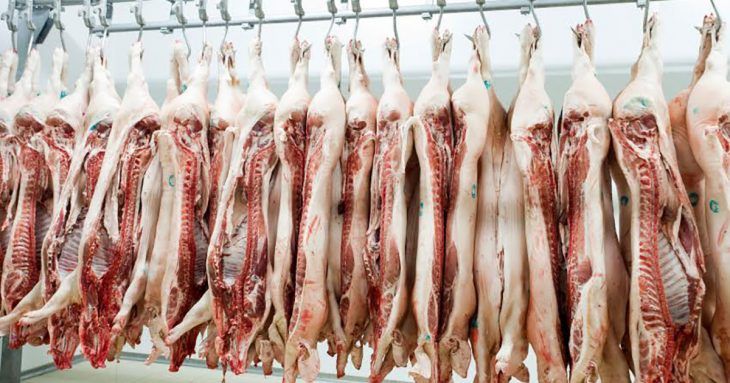Meatpackers struggle amid COVID-19 cases, but significant shortages not expected
by April 20, 2020 3:56 pm 1,934 views

Hormel Foods has temporarily shuttered a processing plant in Rochelle, Ill., after health officials linked two dozen COVID-19 cases to the processing facility that makes bacon, ham and microwavable meals. It’s the latest in a growing list of U.S. meatpacking plant closures.
The planned 14-day shutdown impacts more than 800 workers, and comes on the heels of Tyson Foods plant closure late last week in Perry, Iowa, for deep sanitation. The Tyson plant is set to reopen April 21. Tyson has already shuttered a pork processing plant in Columbus Junction, Iowa, from COVID-19 impact on that workforce. This Columbus Junction pork slaughter plant routinely kills about 10,000 hogs a day and that is capacity that was taken out of the industry.
Other Tyson plants in Iowa have also experienced elevated COVID-19 cases numbers, but the meat giant has remained open outside the Columbus Junction closure since April 6. Tyson is running fewer shifts in some plants because staffing is lower as the company seeks to protect its workforce and still supply retail customers with meat.
Cargill closed a meatpacking in Pennsylvania on April 8 as COVID-19 cases increased. Cargill also temporarily closed another facility in Big Lake, Minn., due to COVID-19 outbreaks in the area. Cargill also is scaling back production in a Fort Morgan, Colo., meatpacking facility after one employee died from COVID-19. Also in Colorado, JBS shuttered its plant in Weld County for two weeks following an outbreak that left four people dead and 102 others infected with COVID-19. Smithfield and National Beef also each closed one packing facility related to COVID-19 outbreaks in recent days.
Livestock Marketing analyst Derrell Peel with the Oklahoma State University Extension Service said this is a trying time for packers and the livestock producers who supply the packing plants. He said losses are adding up for livestock producers as inventory bottlenecks in the supply chain.
FEDERAL AID
He said the federal aid package of $19 billion for the Coronavirus Food Assistance Program (CFAP) announced last week by the U.S. Department of Agriculture will provide $16 billion in direct payments to farmers and ranchers, including $9.5 billion of emergency funding from the CARES Act and $6.5 billion of funding from the Community Credit Corp. (CCC).
He said CFAP also includes $3 billion in purchases of meat, dairy and produce to support producers and provide food assistance to those in need. CFAP is funded from the Coronavirus Aid, Relief and Economic Security Act (CARES), the Families First Coronavirus Response Act (FFCRA) and other USDA programs.
“The beef cattle industry will receive $5.1 billion of CFAP funding to partially offset 2020 losses due to COVID-19. Cattle producers will receive a single direct payment determined by two calculations including 85% of price losses from January 1- April 15, 2020 and 30% of expected losses for two quarters after April 15,” Peel said.
In order to qualify, commodities must have experienced at least a 5% price decrease between January and April. USDA expects to begin sign-up in early May and distribute payments by late May or early June.
BILLIONS IN LOSSES
Peel said payments to cattle producers will only partially offset losses due to COVID-19.
“A study released recently by Oklahoma State University estimated total losses to the beef cattle industry of $13.6 billion including $9.2 billion in 2020 losses. Damage to the cow-calf sector was estimated at $3.7 billion along with $2.5 billion in losses to stocker producers and $3.0 billion in losses to the feedlot sector. Additionally, the cow-calf sector will incur another $4.4 billion in long-term losses if the 2020 damages are not compensated,” Peel said.
He said expected cattle slaughter dropped to 502,000 head last week, down 6.3% from the week prior and down 21.8% from the same week last year. Before decreasing sharply the past two weeks, weekly cattle slaughter had averaged 634,300 head per week for the first 14 weeks of the year, up 4.3% year over year.
“At this time, plant reductions are mostly resulting in some product disruptions and perhaps temporary shortages of fresh meat. Barring a catastrophic combination of plant closures or extended periods of plant disruptions, significant shortages of meat are not expected,” he said.
Peel said the combination of processing disruptions and the continuing challenges of supply chain disruptions mean consumers will likely experience limited meat supplies and selection in grocery stores in the coming weeks.
“Total beef production in 2020 is still projected at a record level over 27 billion pounds but the timing during the year is more volatile and somewhat choppy,” Peel said.
